Discriminative Sentimental NLP Model with Re-Enforcement Deep Learning Model for the Slogan Generation
Автор: Shailesh S. Sangle, Raghavendra R. Sedamkar
Журнал: International Journal of Image, Graphics and Signal Processing @ijigsp
Статья в выпуске: 3 vol.17, 2025 года.
Бесплатный доступ
Effective communication is paramount in election campaigns, and slogans are crucial in conveying messages and eliciting voter sentiment. This paper introduces CRFVReC (Conditional Random Field with Variable-Length Receptive Fields), a statistical modeling technique to categorize and generate election campaign slogans by analyzing their sentiment. It is a novel approach for sentiment-based slogan generation and analysis in election campaigns. The reason was to choose datasets that precisely capture voter sentiment from a variety of sources such as social media (SM) posts, public comments, and news articles. The datasets were meticulously chosen to encompass a broad spectrum of sentiments and issues that are pertinent to voters. The CRFVReC model was set up to maximize the performance of sentiment classification and slogan generation. Modifying parameters such as the length of the receptive field to match the length of slogans enhanced the model's adaptability and increased its accuracy. Utilizing Conditional Random Fields (CRFs), CRFVReC classifies election campaign slogans into optimistic and pessimistic sentiments and generates slogans that resonate emotionally with voters. The key objectives of this study are twofold: first, to accurately classify election campaign slogans into two primary sentiment categories, optimistic and pessimistic, and second, to generate emotionally resonant slogans that can effectively connect with voters. Extensive experiments and sentiment analyses are conducted using a diverse dataset of election campaign slogans to assess the efficiency of CRFVReC. The results highlight the model's remarkable precision in sentiment classification, demonstrating its capability to discriminate between optimistic and pessimistic sentiment in slogans. The model exhibits elevated accuracy, precision, recall, and AUC scores in sentiment classification, utilizing a diverse dataset. Furthermore, CRFVReC showcases its creative potential in generating slogans with emotionally compelling content. Its capability holds significant promise for campaign strategists and political communicators seeking to craft slogans that resonate with voters deeply emotionally. Additionally, the model's adaptability to slogans of varying lengths makes it a versatile tool for election campaign management and strategy development. The CRFVReC emerges as a robust and adaptable solution for sentiment-based slogan generation and analysis in the complex landscape of election campaigns. Its contributions lie not only in inaccurate sentiment classification but also in its potential to shape the narrative of political campaigns through the creation of emotionally impactful slogans. This research contributes to the fields of political communication and campaign management, providing valuable tools and insights for practitioners and researchers.
Election Campaign, Natural Language Processing (NLP), Sentimental Analysis, Slogan, Discriminative Analysis, Conditional Random Field
Короткий адрес: https://sciup.org/15019725
IDR: 15019725 | DOI: 10.5815/ijigsp.2025.03.03


